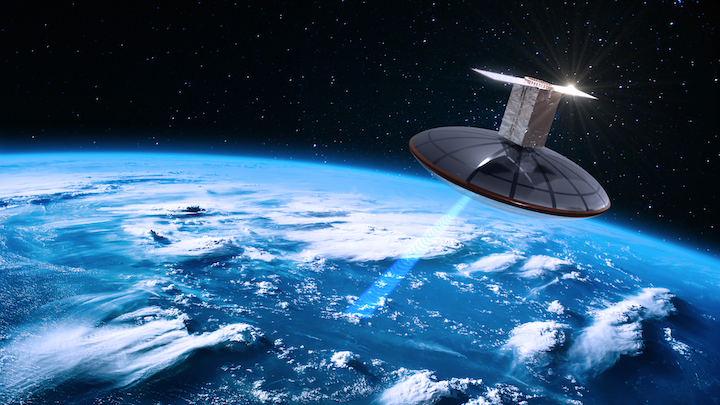Tomorrow.io co-founder explains why the software maker turned to space
A rendering of a Tomorrow.io precipitation radar satellite. Photo: Tomorrow.io
While Tomorrow.io may intend to deploy a constellation of satellites, but did not start out as a space venture. Instead, the weather forecasting software company looked at its growth path, and the founders realized they needed space data.
Tomorrow.io markets itself as a weather intelligence company – it sells software that helps businesses and governments deal with the business impact of the weather. Today, the company is developing a constellation of 32 radar-equipped satellites, designed to provide an hourly updated set of global precipitation data. He recently struck a deal with a Special Purpose Acquisition Company (SPAC) to go public at a valuation of $1.2 billion.
Co-Founder and Chief Strategy Officer Rei Goffer spoke with By satellite about weather intelligence and Tomorrow.io’s decision to build a constellation.
“Weather intelligence is essentially the ability to act. To get actionable insights from a software tool in a scalable way for any type of application, [whether it be] a construction company, an airline, an electric utility or an insurance company,” Goffer said. “It’s not just about getting better forecasts, it’s also about translating those forecasts into actionable insights.”
For example, a utility company in India started using the platform before Cyclone Amphan hit the continent in May 2020. Using information from Tomorrow.io, the company was able to pre-position teams of maintenance near the towers that were expected to be hit by the highest winds and most at risk of damage to power lines. Teams were able to make fixes before there was an outage that would have affected tens of millions of people.

Rei Goffer
The company now has approximately 120 enterprise customers, including Delta Air Lines, Ford Motor Company and Amazon Web Services (AWS). Tomorrow.io brought in around $11 million in revenue in 2021 and expects to earn $28 million this year.
Goffer said the company takes traditional weather data provided by governments around the world and uses a proprietary forecasting model that translates it into actionable data.
But there is a significant information gap that pushes Tomorrow.io into space: precipitation. Goffer said precipitation is difficult to measure, it is currently measured by ground-based rain gauges and ground-based radar which is expensive to maintain and is only common in the United States, Western Europe, Japan and on the Australian coast. More than 5 billion people live outside this radar coverage, and the coverage does not extend over the oceans.
“This gap has huge implications for people’s lives, from not knowing if it’s going to rain, to being hit by floods and cyclones without warning,” Goffer said. “You can’t buy crop insurance, fly safely, or drive safely. There are an endless amount of use cases that we take for granted to live in the United States. »
NASA launched the TRMM (Tropical Rainfall Measuring Mission) and GPM (Global Precipitation Measurement) satellites to try to solve this problem, but these satellites do not have a high revisit rate.
Due to developments in satellite technology, Tomorrow.io discovered that it could develop a radar sensor capable of seeing precipitation from space at a cost that made it economically feasible. To do this, the company hired John Springmann, who developed BlackSky’s constellation and the initial technical architecture for Rocket Lab’s Photon satellite program. Tomorrow.io is building the sensor and manufacturer Astro Digital is building the satellite bus for the first two demo satellites. The first launches are planned for the end of 2022 and the company is actively seeking suppliers for the follow-on satellite buses.
Goffer said Tomorrow.io chose to use partners for parts of the space value chain that are commoditized, like bus, downlinks and launch, but wanted to own its own satellites rather than use the model of space as a service of many companies. start offering. He said that after extensive analysis, Tomorrow.io found “huge gaps” between the space-as-a-service pitch and the reality.
The company says this will expand radar coverage worldwide to cover every point on the globe once per hour on average, compared to the two-to-three-day revisit rate of existing space-based radar missions. The US Air Force is encouraging the company’s mission and awarded Tomorrow.io a $19.3 million contract to support the deployment of its first four satellites.
Goffer said these satellites will provide invaluable information about how the weather moves around the world, which could impact decisions such as hurricane evacuations, and help businesses and governments adapt. extreme weather events caused by climate change.
“The need is global. Nexrad, the ground-based radar system in the United States, has huge blind spots, especially around low-income communities and sparsely populated areas,” Goffer said. “Weather happens everywhere. A storm that will hit the East Coast starts closer to Africa in the ocean and travels for days before hitting. We have very limited understanding of what is happening with the storm until it makes landfall, which is far too late.
Goffer maintains Tomorrow.io’s identity as a software company that goes into space to enable its mission.
“All Earth observation companies started with a sensor, regardless of the need to know who cares about the data and how the data is used. Our case is completely different. We are a company of software in a certain vertical, which we know and understand very well, and we have customers. We have identified a gap that can be solved from space, and therefore our space travel is a means to an end “, he said. “We are very proud to go into space as a software company that will remain a software company, leveraging space.”


Comments are closed.